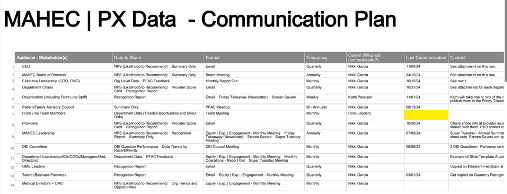Enhancing Patient Care in FQHCs: The Essential Role of a Communication Plan

By Nikki Garcia, CPXP, Patient Experience Officer
FQHCs are instrumental in providing essential healthcare services to underserved communities. Their mission to offer accessible and high-quality care drives their daily operations and influences their approach to addressing the specific needs of their patient populations. By employing effective communication strategies, FQHCs ensure they remain responsive to the evolving needs of the communities they serve, ultimately contributing to a more equitable healthcare system.
As W. Edwards Deming once said, “Without data, you’re just another person with an opinion.”
As patient experience professionals, we already know the value of patient experience data. It is an integral part of any successful patient experience program and is essential for obtaining buy-in from key stakeholders. Less talked about, though, is the usefulness of developing a patient experience communication plan to ensure that the right data is being shared at the right time. Communication plans not only promote continuous communication and accountability within an organization but also serve as helpful succession planning and cross-training documents.
If you’re not familiar with the term “communication plan,” it is a strategic document that contains important information about what to communicate, with whom, and at what frequency. It also clearly indicates who is responsible for sharing specific information and in what format it can be expected. In large organizations, having a communication plan is an essential strategy for ensuring that leaders know what is expected of them and for the rest of the organization to know what to expect from their leaders.
I occasionally hear people say they don’t need a written plan, confident that all the details about their work and its stakeholders are safely stored in their mind—or in the mind of the leader overseeing it. And they’re probably right! But it still begs these questions:
What if your main leader ends up leaving your organization unexpectedly?
What if they have to take a leave of absence?
What if someone else needs to be asked to cover their daily duties while they are away?
Would they know what to do?
If the answer isn’t yes to these questions, a communication plan may be exactly what you need.
The 7 Steps of Developing A Communication Plan
Step 1. Identify existing data sources.
Listing these helps illustrate what’s already available and reveals gaps where additional data could enhance insights. This approach not only builds a clearer picture of possibilities but also highlights new opportunities for data collection. The first time I started writing out our data sources, I started by listing what I was already reviewing daily. Then I realized there were other sources – like operations data that would broaden our understanding of the bigger picture – that we also needed to consider.
Other data sources to explore:
- Post-Visit Surveys – Most organizations already have a post-visit survey, whether it’s due to regulatory requirements or otherwise. It Is especially useful to be able to stratify the data to the clinic location and provider level. Including patient information in your data (like race, ethnicity, gender, and sexuality) also allows for the stratification of experience by identity, which provides the opportunity to identify and eliminate potential disparities.
- Employee Engagement Surveys – At MAHEC, there is one question in particular on our employee engagement survey that provides the most valuable patient/family experience data. It is from the question “How likely are you to recommend MAHEC as a great place to receive care to a friend/loved one?” This question allows us to compare data from the experience of our patients and the experience of our team members as patients, and it has yielded unexpected but helpful results.
- Leadership Rounding Documentation – The insights gained from casually checking in with patients and team members during your rounds in the facility can be astonishing. This approach not only fosters a culture of open communication but also serves as an effective means to validate or challenge hypotheses formed from survey data.
- Patient/Family Advisory Council (PFAC) Meeting Minutes – PFAC meeting minutes are a valuable source of data because they can reveal patterns in patient needs, concerns, and expectations, as well as actionable ideas for improving care delivery. Additionally, PFAC meeting minutes provide qualitative data that can highlight trends in patient priorities, identify potential service gaps, and uncover areas for enhancing communication and support.
- Online Reviews – By leveraging online reviews from platforms like Google, Yelp, and Healthgrades, healthcare teams can create a more comprehensive view of patient experience, making it easier to drive improvements that align with patient expectations.
- Operations Data – Reviewing data on “Third Next Available Appointment,” a widely used patient access metric, alongside survey data on Perception of Access is a prime example of how to integrate operational data to develop a more comprehensive data dashboard. By combining these metrics, you can gain deeper insights into patient challenges and experiences around access.
Leveraging a diverse array of data sources is essential for developing a comprehensive understanding of patient experience. Each of the highlighted sources provides unique insights that contribute to a holistic view of care delivery. By analyzing this information in conjunction with demographic data, organizations can identify disparities, enhance communication, and ultimately improve patient outcomes.
Step 2. Identify your organizational stakeholders.
This is your target audience. It’s important to consider all levels of the organization as you build your audience list. This includes front line workers, as well as your patients and community members.
Step 3. Decide which data is most meaningful for each audience/stakeholder.
It can be tempting to share all the data you have with everyone—this way you’re being completely transparent, and people can focus on what they need. The challenge with this approach is that sometimes people don’t know what they need, or they lose interest in the data before completely understanding it, especially when the content isn’t relatable to their day-to-day work. For this reason, we recommend doing the work ahead of time to find the most meaningful data.
Step 4. Decide how to communicate the information – and at what frequency.
Marketing research shows that a person has to hear something at least seven times, usually in different ways, before a message sticks. Keep this in mind as you consider the frequency in which to communicate each piece of data, as well as the format to use. At MAHEC, we use a variety of different communication methods to recognize staff for outstanding performance including thank you cards, newsletter announcements, and employee-facing screen savers. One size doesn’t fit all. Based on feedback from leadership and front-line team members, adjust the format and frequency as needed.
Step 5. Assign an owner; decide who is responsible for communicating with each audience.
In larger organizations, multiple leaders may be responsible for communicating specific data elements. To facilitate this process, it is essential to clearly document ownership and ensure that each leader understands their responsibilities. This clarity not only helps prevent delays but also designates the appropriate contact for updates if a task is overdue.
Many programs incorporate a “Tagging” feature that sends automated email alerts to team members about their tasks and deadlines, based on the individuals listed in the “Owner” column of the communication plan. At MAHEC, we utilize Smartsheet, which allows users to input contacts in the ownership column. When team members are assigned tasks, they receive notifications regarding the information in their respective rows, along with any related action items and timelines. This streamlined communication enhances accountability and keeps everyone informed of their responsibilities.
Step 6. Track your Progress – Date of Last Communication and Date of Next Planned Communication.
These two data columns are especially useful to support coverage or succession planning. Anyone with access to the document can easily see when the last communication occurred and when the next one is expected. In some software, like SmartSheet, you can attach links to documents, email memos or PDFs that contain the exact communication/data that was sent out.
Step 7. Review a draft of your plan with stakeholders and solicit feedback about needed adjustments.
This step is crucial. Making a draft of a communication plan is a great place to start, especially when you’re just starting out. But a plan shouldn’t be finalized without stakeholder input from key individuals from your Patient Family Advisory Council or executive leadership team. The truth is, we may THINK we know what data people will want to see, but each person is a little different. It’s also helpful to gather feedback from front-line team members about what they find the most interesting and the data that would be most useful to them.
In conclusion, this multifaceted approach not only supports continuous quality improvement initiatives but also fosters a culture of collaboration and accountability across the organization. Ultimately, harnessing these varied data sources empowers FQHCs to respond effectively to the needs of their patients, ensuring a patient-centered experience that aligns with organizational goals and values.

Sample Communication Plan dashboard
About the Author
Nikki Garcia is a passionate healthcare professional, dedicated to improving the experience of care for all in Western North Carolina, especially the underserved, ensuring that care is provided to all people in an equitable manner. Nikki received her Bachelor of Science in Health and Wellness Promotion in 2017 from the University of North Carolina Asheville. Her diverse experience over the last decade has included accompanying survivors of sexual assault as they are examined in the emergency room, scheduling for an outpatient sleep center, and most recently, managing multiple departments within a private neurology practice. She currently serves as the Patient Experience Officer for Mountain Area Health Education Center in Asheville, where she is responsible for leading and implementing patient experience improvement initiatives within the organization. She also has the pleasure of facilitating the organization’s Patient/Family Advisory Council.
Related content
-
 Policy & Measurement
Policy & MeasurementUnveiling Patient Satisfaction: Exploring Demographics, Interactions, and Health-Seeking Behavior
Objective: This study examined the social context of the patient visit (demographics, waiting room experience, patient-provider interaction) and their relationship to satisfaction with the quality of care when seeking medical treatment. It also examined satisfaction as a predictor variable for its effect on three patient behavioral outcomes. Methods: The study was implemented using a cross-sectional quantitative design among
Learn more -
 Policy & Measurement
Policy & MeasurementUnleashing Collective Potential: The Power of Team-Based Leader Rounding in Elevating Patient Care
Baylor Scott & White Medical Center faced a decline in patient experience scores, reaching the 50th percentile by 2022 due to inconsistent leader rounding and lack of focus on improvements. In 2024, the center revamped its rounding program by involving non-clinical and ancillary leaders, focusing on structure, support, and connections. This approach included protected time
Learn more -
 Policy & Measurement | Quality & Clinical Excellence
Policy & Measurement | Quality & Clinical ExcellencePX Pulse: Consumer Perspectives on Patient Experience in the U.S. – November 2023
The latest release of PX Pulse reveals the items of greatest importance to healthcare consumers remain consistent from the previous quarter, but perspectives on the quality of care and overall experience saw the lowest scores in the last two years. This issue also explores the critical issues of trust, provider relationships and providing feedback to
Learn more
